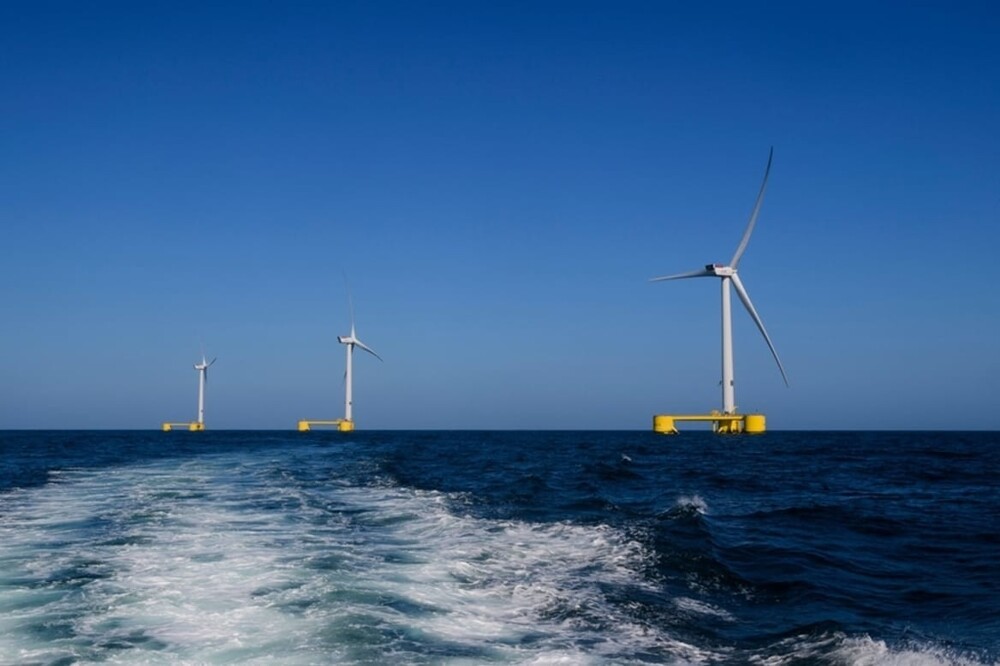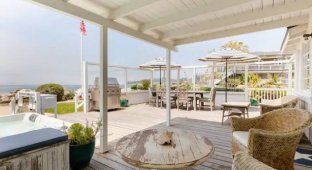Portugal ran on 100% renewable energy for six days in a row (4 photos)
For nearly a week, the country of 10 million has been meeting its electricity needs with wind, hydroelectric and solar power, a trial run for running a power grid free of fossil fuels. 
The author of the article is Julian Spector, Canary Media. 
Wind turbines, Santa Cruz, Madeira Island, Portugal
One autumn day I watched the gusts of the Atlantic Ocean collide with the cliffs overlooking Nazaré, Portugal. The rain poured down and the waves rose into walls of water that even the most crazy surfers could only reach by jet ski. To me it looked like the end of the rain, an end-of-season beach holiday, but for the piece of Iberia that is Portugal, it looked like a bright future. That weekend, the nation of 10 million was running on wind, solar and hydropower alone.
As it turned out, these rainy and cloudy days were just a warm-up. From October 31 to November 6, Portugal produced more than enough renewable energy to serve all its customers for six days in a row.
“Gas stations were on standby, expecting to be able to provide energy if necessary. That didn't happen because the wind was blowing, it was raining heavily, says Hugo Costa, who oversees Portugal at EDP Renewables, the renewable energy division of the state-owned company that was privatized in 2012. “And we produced products that had a positive impact on consumers because prices dropped dramatically, to almost zero.”
To achieve the climate goals of the Paris Agreement by 2050, countries must operate carbon-free not just for three to six days, but all year round. Some countries are already doing this thanks to large reserves of hydroelectricity that were created long before the climate crisis began to drive investment decisions for power plants. Other countries have high rates of carbon-free energy thanks to large nuclear power plant fleets.
Portugal falls into another, more understandable category: At the beginning of its decarbonization journey, it had some old hydroelectric power plants, but no nuclear capacity and no plans to build any. This means it has had to look for ways to reduce its consumption of fossil fuels by maximizing the use of new renewable energy sources.
How was Portugal able to achieve this? It committed to building renewable energy early and often, and to achieving net-zero carbon emissions by 2050, in 2016, several years before the European Union as a whole found the courage to do so. The last coal plants in Portugal were closed in 2022, leaving (imported) fossil gas as a backup on-demand energy source. 
Dam and hydroelectric power station in Bemposta, Miranda do Douro, Portugal
“The main conclusion, in my opinion, is that the Portuguese energy system is prepared for a very high share of renewable electricity and its expected fluctuations. We were able to cope with both a surge in hydro and wind power production and a return to a lower share of renewables when gas-fired power plants were again needed to supply part of the country's demand,” said Miguel Prado, who covers Portugal's energy sector for Expresso newspaper.
The goal of decarbonizing Portugal's energy system is to reduce, and ultimately reduce to zero, the number of hours the country needs to burn gas to keep the lights on. The country's leadership wants gas-fired generation, which accounts for 21% of electricity consumption between January and October, to be completely phased out by 2040.
To achieve its climate goals, Portugal has focused on diversifying renewable resources: rather than relying primarily on wind, water or solar, it is adding each to its portfolio and finding ways to make them more complementary. The country's electric utilities are now seeking additional opportunities for offshore wind development, expanding solar installations and retooling older onshore wind projects to make the most of the most suitable locations.
Anatomy of a six-day experiment
After the overthrow of the authoritarian Estado Novo dictatorship in 1974, the newly formed state company Energias de Portugal built a series of hydroelectric dams on the once wild rivers that rushed from the eastern mountains to the western coast. The company built its first onshore wind projects in the 1990s, when solar simply couldn't compete economically and solar installations had only recently begun to take off.
This is why cloudy skies did not impact overall renewable electricity production during a recent 6-day experiment, as would have happened in California or Hawaii, for example. Wind and hydropower worked, and that's the main thing.
Any milestone in the fast-growing clean energy industry must have specific parameters. So what exactly has the Portuguese power grid achieved this month?
The six-day record is 149 consecutive hours during which “renewable energy exceeded industrial and residential consumption needs across the country.”
The previous record for this indicator was achieved in 2019 and was 131 hours (just over five days). This does not mean that fossil fuel plants were not operating, but that the total electricity generation from renewable sources more than met the needs of consumers.
But Portugal also just set a national record for meeting the needs of the entire energy system “without using conventional thermal generation.” This gas-free period began on Halloween night and lasted 131 consecutive hours, about 5 days, almost tripling Portugal's previous record set in 2021 of 56 consecutive hours. And for 95 of those hours, Portugal exported clean electricity to Spain because it consistently had more than it needed—again, without using gas.
This trend line is what you need to follow. Weather favorable to renewable energy will come and go, and the shoulder seasons (March, April, October, November) are right for renewable energy to outpace consumer demand as heating and cooling needs are lower than in the summer and in winter. However, the last time Portugal had ideal conditions for a renewable energy record, it only lasted a third of the time without burning gas. As new wind and solar capacity comes online, Portugal is expanding its arsenal to run exclusively on renewable energy sources.
This week has been special, but it is an example of a historic shift in energy consumption. Between January and October, the use of natural gas for electricity production in Portugal fell by 39% compared to the previous year, according to REN. As a result, total gas consumption in Portugal reached its lowest level since 2006.
Portugal has made decarbonization of its energy systems a tangible reality for itself. To achieve its climate goals, it needs to take the pattern developed during one week in November and run it over longer periods of time until eventually gas is not required even on standby. Moreover, this must be done even during those periods of the year when winds and rains will not bother off-season tourists who have heard so much about a climate reminiscent of Southern California.
Next steps to decarbonize energy systems
Portugal's clean energy achievements today build on a number of decisions made in the past: the country decided to invest in new hydropower capacity, and 18 years ago it held a large-scale auction of wind farms, Prado noted.
“It is also important that the country did not make large-scale investments in solar energy when this technology was still expensive,” he explained. “Portugal is now facing huge demand from developers to build new utility-scale PV plants, as well as strong demand for decentralized solar projects, taking advantage of low-cost technology to increase the share of renewable energy in the coming years.”
Prado added that the country still faces a difficult task in achieving the national goal of 85% renewable energy by 2030. Key challenges include slow permitting processes and the challenges of balancing environmental impacts with the need for clean energy.
One way to mitigate delays in issuing permits for new stations is to renovate old ones.
According toovam Costa, Portugal has limited territory, and the best sites for onshore wind power are already occupied. However, early designs still use 500-kilowatt turbines, while new turbines can produce 6.2 megawatts. Thus, replacing an old turbine with a new one can free up 12 times more existing capacity. EDP Renewables does this strategically to increase production during periods when projects are not reaching full export capacity; These upgrades produce more clean electricity throughout the year without requiring investments in the grid to accommodate power surges.
EDP Renewables is also exploring the possibility of creating hybrid power plants that combine wind and solar installations.
“When we combine wind and solar, they complement each other very well,” Costa said. — Usually, when the wind blows here, there is no sun. And when we have sun, we generally don’t have as much wind.”
Clustering projects together in this way helps diffuse the fixed costs of construction, making them “more economically efficient,” Costa added. In other words, developers can save money compared to building the same resources in separate locations.
There are currently no large off-grid battery stations in Portugal, although some batteries are installed next to solar or wind farms. Batteries built into hydropower networks have so far been sufficient to balance fluctuations in other types of generation. But as the share of renewables in electricity production grows, the need to quickly store and discharge energy will require more batteries, Costa said.
The most ambitious part of Portugal's clean energy expansion isn't even happening within Portugal's land borders. Having chosen the most suitable locations on land, energy workers will increase the number of wind turbines, turning to sea waters that are so deep that they require floating turbines. Several pioneering projects by other countries have proven that this is possible, but the method remains much less mature than installing turbines on the seabed.
In 2011, EDP Renewables tested a 2-megawatt floating turbine supplied by US company Principle Power, which bravely withstood the impacts of 17-metre waves off northern Portugal. After this, the company produced three floating turbines with a capacity of 8.4 MW and was even able to obtain project financing from the European Investment Bank. 
Windfloat Atlantic floating wind farm, located approximately 20 km off the coast of Viana do Castelo in northern Portugal
“We have a lender who is confident in the cash flows generated by the project and is not relying on any guarantees from the sponsor,” Costa said.
Financiers tend to be wary of new technologies that they perceive as risky; This approval is an important step towards making floating wind a mainstream clean energy tool.
This is exactly what Portugal is aiming for: Its goal is to build 10 gigawatts of offshore wind, which must be floating. There is still a lot of work to be done to achieve this goal, so Costa said results can't be expected until the 2030s. However, in December the government intends to hold an auction for 2 gigawatts of offshore projects.
That timeline has become less certain since Prime Minister Antonio Costa resigned last week amid a corruption investigation involving green hydrogen and lithium interests.
“This government will not be able to make relevant decisions in the coming months, until the elections in March, which will delay the launch and completion of the first offshore wind auction,” Prado said. Other auctions on green hydrogen, renewable fuels and energy storage devices will also likely be delayed.
This unexpected hiccup will not change the broad political consensus on the need for more clean energy. But for now, only surfers and fishing boats will battle the huge Atlantic waves.





























